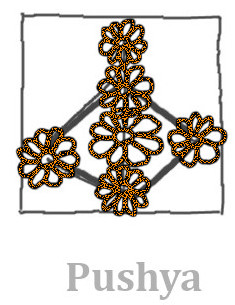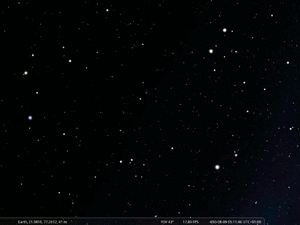Pushya: Difference between revisions
No edit summary |
|||
| Line 3: | Line 3: | ||
[[File:8 Pushya stellarium.gif|thumb|Pushya, 8th Nakshatra, drawn as an arrow in Cancer.]] |
[[File:8 Pushya stellarium.gif|thumb|Pushya, 8th Nakshatra, drawn as an arrow in Cancer.]] |
||
Puṣya (पुष्य) is an Indian name, used by the Indian Vedic tradition. Most of these names are roughly 3000 years old. They pre-date Hinduism but were taken over by it. Pushya is identified with the stars γ, δ and θ Cancri that surround the star cluster M44. Its appearance is described in Indian star catalogs with the term '''meghavt''<nowiki/>', cloudy/ nebulous (मेघ , megha, cloud), which refers to the open star cluster itself. |
Puṣya (पुष्य) is an Indian name, used by the Indian Vedic tradition. Most of these names are roughly 3000 years old. They pre-date Hinduism but were taken over by it. Pushya is identified with the stars γ, δ and θ Cancri that surround the star cluster M44. Its appearance is described in Indian star catalogs with the term '''meghavt''<nowiki/>', cloudy/ nebulous (मेघ , megha, cloud), which refers to the open star cluster itself. |
||
==Etymology and History== |
==Etymology and History== |
||
| Line 17: | Line 17: | ||
Yet, as the image found in historical depictions is an arrow with only one (bright) star, it suggests that the feathers of the arrow actually represent the group in and around M44. The bright star is α CMi ([[Procyon]]) that rises simultaneously with the faint stars in Cancer was likely used as a marker for them, in particular during twilight observations. Thus, the arrow could be the imagined line between the actual nakshatra group and the observed bright star as indicator. |
Yet, as the image found in historical depictions is an arrow with only one (bright) star, it suggests that the feathers of the arrow actually represent the group in and around M44. The bright star is α CMi ([[Procyon]]) that rises simultaneously with the faint stars in Cancer was likely used as a marker for them, in particular during twilight observations. Thus, the arrow could be the imagined line between the actual nakshatra group and the observed bright star as indicator. |
||
{| class="wikitable" |
|||
!Pushya |
|||
!Vedic |
|||
!Tirupperunthurai |
|||
!Chinese |
|||
!(Jones 1790) |
|||
|- |
|||
| |
|||
| '''meghavt''<nowiki/>' |
|||
|6 stars |
|||
|5 stars |
|||
|2 stars |
|||
|- |
|||
| |
|||
| colspan="3" |obviously always the quadrilateral surrounding the star cluster, |
|||
sometimes with an additional star |
|||
| |
|||
|} |
|||
=== Transfer and Transformation of the Constellation === |
=== Transfer and Transformation of the Constellation === |
||
<gallery> |
<gallery> |
||
Latest revision as of 10:13, 18 November 2025
Puṣya (पुष्य) is an Indian name, used by the Indian Vedic tradition. Most of these names are roughly 3000 years old. They pre-date Hinduism but were taken over by it. Pushya is identified with the stars γ, δ and θ Cancri that surround the star cluster M44. Its appearance is described in Indian star catalogs with the term 'meghavt', cloudy/ nebulous (मेघ , megha, cloud), which refers to the open star cluster itself.
Etymology and History
Name Variants
- Puṣya,
- Pushya
- Sidhya
- Tiṣya
Origin of Constellation
The term literally means "the Nourisher" and therefore causes the same association of the star cluster in Cancer like the Greek "manger" that survives in the Latin name of the star cluster M44: Praesepe.
Yet, as the image found in historical depictions is an arrow with only one (bright) star, it suggests that the feathers of the arrow actually represent the group in and around M44. The bright star is α CMi (Procyon) that rises simultaneously with the faint stars in Cancer was likely used as a marker for them, in particular during twilight observations. Thus, the arrow could be the imagined line between the actual nakshatra group and the observed bright star as indicator.
| Pushya | Vedic | Tirupperunthurai | Chinese | (Jones 1790) |
|---|---|---|---|---|
| 'meghavt' | 6 stars | 5 stars | 2 stars | |
| obviously always the quadrilateral surrounding the star cluster,
sometimes with an additional star |
||||
Transfer and Transformation of the Constellation
Mythology
mnemonic tales and cultural significance
Weblinks
References
- References (general)











